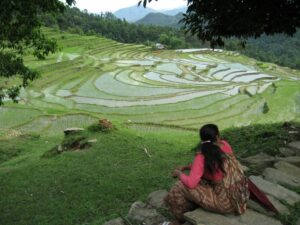
In southern Travancore, Kerala State in India, many ancestral homes are located close to large stretches of erstwhile paddy fields. Families living in these homes used to cultivate rice. Today, the paddy fields are gone. Massive fields in Thiruvananthapuram, the capital of Kerala, have been slowly but steadily turned into sprawling estates, to meet the ever-increasing demand for living space. Many traditional houses have been demolished. Along with them, all rice-based rituals have become a part of the nostalgic memories of the elders.
A spiritual bridge to the stars
One of the rituals can still be found in and around the capital: the tradition of worshipping antlers or a sculpture of a deer’s head. These antlers are housed in shrines called thekkathu, which stand on the southeastern corner of houses. Neither questioning the practice nor knowing its actual meaning, those who continue this tradition have no immediate explanation for the worshiping done for generations.
Antler worship is also practiced on Bali island, in Java, Indonesia, more than 4,500 km east of Kerala. Long ago, farmers turned to the stars to determine when to plant and harvest rice One can find thousands of shrines carrying antlers. Antler worship is related to plowing by way of language. The Malayalam (a major southern Indian language) and the Balinese words for plow (nangol and tengala, respectively) are correlated with the constellation Makayiram (antler or antelope’s head).
Westerners know Makayiram as Orion, the hunter. This constellation, located on the celestial equator, is one of the most conspicuous and most recognizable cosmic patterns in the night sky.
According to the Aitareya Brahmana, an ancient Indian collection of sacred hymns, the three stars on the head of Orion (Lambda Orionis or the Meissa Ring) formed one of the Hindu lunar stations known as “the antelope’s head.”
Rice and the cosmic plow
Many practices are tied to Makayiram or Orion throughout the ancient world.
The Javanese viewed the stars in Orion’s belt (Alnitak, Alnilam, and Mintaka) and three of the four outer stars, Rigel, Saiph, and Bellatrix, excluding Betelgeuse, as a plow and they named the constellation Bintang Weluku after their traditional plow, weluku.
The rice farmers in Java believed that Orion regulated the different seasonal activities in rice farming. Over the years, the Javanese observed the celestial upright plow at both predawn and sunset. The start of the new agricultural year is marked by the first appearance of “the plow” during the summer solstice (20 to 22 June, depending on the year). Its subsequent rise in the sunset sky was considered to be the time for women to sow the paddy in the nursery and for men to plow the fields.
In Jogyakarta in Central Java, ritual practitioners placed paddy rice on their palm while facing east at dusk. They raise their arm straight toward the belt of Orion. Planting season begins when the position of the stars is high enough so that an angle of the arm causes the grains to roll down from an open palm.
The rice stars
Before the Chinese introduced methods for determining a lunar calendar, early Japanese farmers also relied on Orion’s belt, which they called Mitsu Boshi, for signs of when to plant their crops. The farmers, however, viewed the three stars of Mitsu Boshi not as a belt but as a fulcrum, with Alnilam as the center balancing Mintaka (representing the yield of millet) and Alnitak (the yield of rice). Across Japan, Mitsu Boshi rises in a vertical position. As it moves across the sky in the fall, Alnitak appears to be higher than Mintaka. This is known as Komeinya Boshi (rice stars), the time to harvest rice and plant millet. As the constellation is seen setting in the west in late spring, Almitak begins to dip lower and lower than Mintaka and becomes Komeinya Boshi (millet stars), the time to harvest millet and plant rice.
The astrology of rice farming
Aside from Orion, early farmers relied on other star formations as well. In the constellation of Taurus, Pleiades (or the Seven Sisters) often served as important calendar markers for many cultures around the world. The Maloh people in West Kalimantan, Indonesia, used the stars for their cue when clearing, felling, burning, and planting of rice was to take place. The planting season would begin when ritual practitioners looked up to gaze at Pleiades and the hats on their heads fell off.
On the other hand, muzhakkol (measuring scale), a Verdic constellation in Dhanu (Sagittarius), indicates the time for treading the wheel previous to sowing. To clear a rice field of water, preparatory to sowing, is chakram chavittuka. The word kalappaichakram, in Tamil, denotes a diagram in astrology in the form of a plow to determine the best day for plowing. As the use of calendars spread, they provided farmers with more precise methods to determine when to plant and harvest rice and other crops. But, before that, though separated by incomprehensible distances, farmers looked up at the night sky and sought the guidance of the stars.
_________________________________________
Dr. Nair is an academic and Indologist whose book Rice and Culture (in Malayalam language), published by the State Institute of Languages in Kerala,argues that rice cultivation originated in India. His ensuing book on the History of Ploughing Ceremonies brings forth more evidence on this hypothesis.









